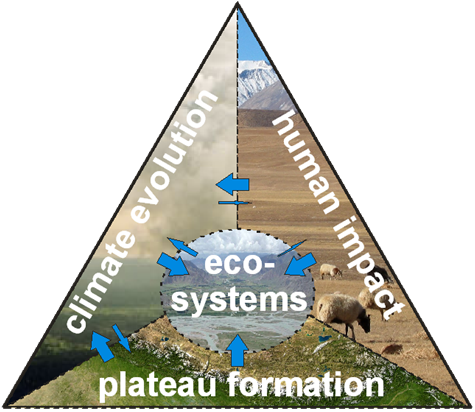Masterarbeit
Chamber based carbon dioxide fluxes of three different vegetation treatments on the Tibetan Plateau
Jürgen Leonbacher (11/2012-05/2013)
Betreuer: Tobias Biermann, Wolfgang Babel, Thomas Foken
Geoökologie, Univ. Bayreuth
The Tibetan–Qinghai Plateau is seen as the worlds largest alpine ecosystem, covering an area of about 2.5·106 km2 with an elevation higher than 4000 m. The major ecosystem type of the Plateau are Kobresia pygemaea (Cyperaceae) pastures, which are considered as protection from soil erosion, but are still heavily used for livestock grazing. However, it can be observed, that these pastures undergo an increasing degradation accompanied with a decreasing trend in vegetation cover. This, primarily attributed to human activities, whereas natural causes for the decline in vegetation cover are not yet fully understood and still discussed in the scientific community. To investigate the contribution of the Tibetan Plateau to the global carbon budget, several studies conducted CO2 –flux measurements, recently. Thereby, mainly only intact plant communities were investigated. But accord- ing to the degradation of these Cyperaceae meadows and the decline in surface cover, it considerably gets relevant to investigate also the stages of degradation on their CO2 balance. In this study, three stages of degradation are defined as treatments on the basis of oc- curring plant species and their spatial cover. The three different treatments are named as Intact Root Mat, Degraded Root Mat and Bare Soil. These treatments were investi- gated on their CO2 balance, by applying CO2 –flux chambers, which measured both Net Ecosystem Exchange (NEE) and Ecosystem Respiration (Reco ). The study was carried out at the KEMA field site during the growing period of 2012, between the 30th of July and 26th of August. The results clearly indicate large differences in the magnitude of measured fluxes between the three different treatments, whereby measured CO2 –fluxes were highest for Intact Root Mat and lowest for Bare Soil, with intermediate fluxes measured for Degraded Root Mat. Although this result was generally expected, another finding was more striking. Namely, that the fluxes of Intact Root Mat show an up to twofold increase in magnitude, between the beginning and the end of the observation period. However, the opposite trend was expected, due to decreasing temperatures and incoming global radiation, throughout the observation period. Especially, because the named parameters embody the most influ- encing forcing parameters for Reco and NEE. But, closer investigations on other forcing parameters revealed, that evidentially at the beginning of the observation period, the ecosystem was water limited, which effected both Reco and NEE fluxes.

